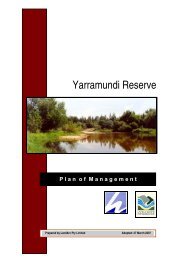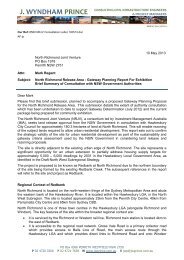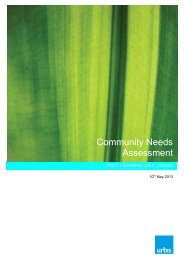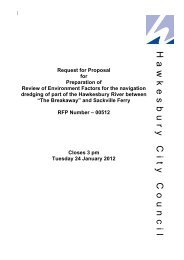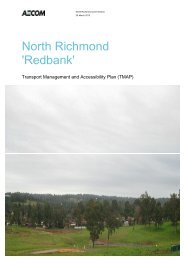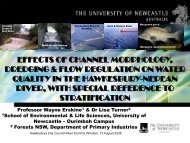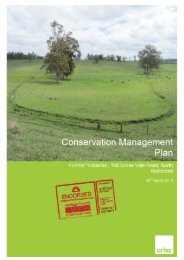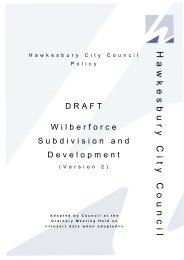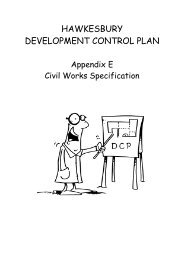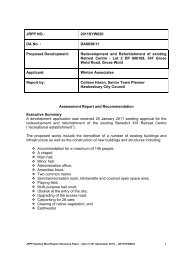Attachment 1 to Item 53 - Roadside Vegetation Management Plan
Attachment 1 to Item 53 - Roadside Vegetation Management Plan
Attachment 1 to Item 53 - Roadside Vegetation Management Plan
You also want an ePaper? Increase the reach of your titles
YUMPU automatically turns print PDFs into web optimized ePapers that Google loves.
H AW K E S B U R Y C IT Y C O U N C IL R O AD S ID E V E G E T AT IO N M AN AG E M E N T P L AN<br />
• If work areas are within high or medium conservation priority roads or near protected<br />
areas, prevent lives<strong>to</strong>ck within roadside environments.<br />
6.6 NATIVE FAUNA MANAGEMENT<br />
As noted in Section 3.5, where areas of high conservation value vegetation abuts roads, probabilities of<br />
collisions between vehicles and native fauna can increase, resulting in road kill of native fauna. Roads<br />
may also act as barriers <strong>to</strong> fauna movement across the landscape. Thus, there are issues relating <strong>to</strong><br />
native fauna management that are related <strong>to</strong> the maintenance of fauna habitat within roadside<br />
environments, but these are slightly different management issues.<br />
There are a number of spatio-temporal fac<strong>to</strong>rs which contribute <strong>to</strong> the incidence of road kill along roads.<br />
Some of these fac<strong>to</strong>rs include season, time of day, roadside features (presence of cover, curves, road<br />
cuttings, drainage lines), fauna behaviour, traffic speed and traffic volume (Forman et al. 2003). There<br />
are also a number of fac<strong>to</strong>rs which contribute <strong>to</strong> roads preventing fauna from crossing them (eg. fauna<br />
behaviour, and traffic speed and volume). As many of these fac<strong>to</strong>rs are unrelated <strong>to</strong> roadside<br />
environments or may involve providing or building structures along roads (such as fences, overpasses,<br />
and underpasses), a full prescription of management actions attempting <strong>to</strong> prevent or reduce the<br />
incidence of road kill is outside of the scope of this RVMP. Even so, some management actions relating<br />
<strong>to</strong> roadside vegetation are provided below.<br />
• While observing the vertical clearance identified in section 6.1 for road safety purposes,<br />
allow for tree branches (which are deemed safe) above identified height <strong>to</strong> extend over the<br />
road unless they are deemed unsafe (i.e. hollow, burnt out, trunk is not thick enough <strong>to</strong><br />
hold the weight of the branch). This will allow for arboreal mammals <strong>to</strong> move across the<br />
road at height rather than at ground level;<br />
• Do not mow or slash vegetation directly adjacent <strong>to</strong> roads along high and medium<br />
conservation priority roads outside of the road safety prescriptions identified in section 6.1.<br />
This encourages many fauna species <strong>to</strong> move <strong>to</strong> roadsides, making them more susceptible<br />
<strong>to</strong> being killed by passing vehicles.<br />
It should be noted that comprehensive management of roadside environments for the prevention of<br />
collisions between vehicles and fauna resulting in road kill involves more than the management of<br />
roadside vegetation and provision of mitigating road structures. For example, driver education and<br />
driver management influencing driver behaviour is an effective means by which road kill can be<br />
reduced.<br />
6.7 WEED MANAGEMENT<br />
The general principal behind the actions provided is <strong>to</strong> prevent weed spread in<strong>to</strong> areas not currently<br />
infested. It is important that work practices which reduce the spread of weeds in<strong>to</strong> areas not currently<br />
infested, including wash down and decontamination of vehicles, importation of weed free soils and road<br />
making materials, training staff in appropriate identification of weed species and appropriate methods of<br />
control, are adopted. This work will be undertaken by the local control authority, the Hawkesbury River<br />
County Council.<br />
The following actions detail how weeds should be managed.<br />
• Moni<strong>to</strong>r outbreaks of declared noxious weeds, WoNS and significant environmental weeds<br />
in the Hawkesbury LGA, particularly near roadsides;<br />
• Produce a strategy <strong>to</strong> control (and where possible eradicate) such outbreaks;<br />
© E C O L O G I C AL AU S T R AL I A P T Y L T D<br />
52



